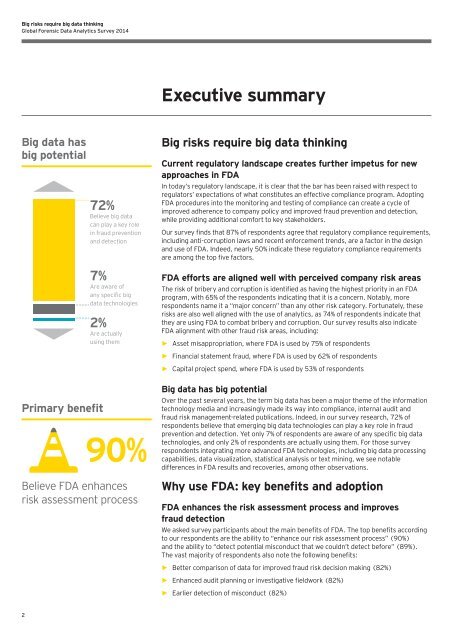EY-Global-Forensic-Data-Analytics-Survey-2014
EY-Global-Forensic-Data-Analytics-Survey-2014
EY-Global-Forensic-Data-Analytics-Survey-2014
Create successful ePaper yourself
Turn your PDF publications into a flip-book with our unique Google optimized e-Paper software.
Big risks require big data thinking<br />
<strong>Global</strong> <strong>Forensic</strong> <strong>Data</strong> <strong>Analytics</strong> <strong>Survey</strong> <strong>2014</strong><br />
Executive summary<br />
Big data has<br />
big potential<br />
72%<br />
Believe big data<br />
can play a key role<br />
in fraud prevention<br />
and detection<br />
7%<br />
Are aware of<br />
any specific big<br />
data technologies<br />
2%<br />
Are actually<br />
using them<br />
Big risks require big data thinking<br />
Current regulatory landscape creates further impetus for new<br />
approaches in FDA<br />
In today’s regulatory landscape, it is clear that the bar has been raised with respect to<br />
regulators’ expectations of what constitutes an effective compliance program. Adopting<br />
FDA procedures into the monitoring and testing of compliance can create a cycle of<br />
improved adherence to company policy and improved fraud prevention and detection,<br />
while providing additional comfort to key stakeholders.<br />
Our survey finds that 87% of respondents agree that regulatory compliance requirements,<br />
including anti-corruption laws and recent enforcement trends, are a factor in the design<br />
and use of FDA. Indeed, nearly 50% indicate these regulatory compliance requirements<br />
are among the top five factors.<br />
FDA efforts are aligned well with perceived company risk areas<br />
The risk of bribery and corruption is identified as having the highest priority in an FDA<br />
program, with 65% of the respondents indicating that it is a concern. Notably, more<br />
respondents name it a “major concern” than any other risk category. Fortunately, these<br />
risks are also well aligned with the use of analytics, as 74% of respondents indicate that<br />
they are using FDA to combat bribery and corruption. Our survey results also indicate<br />
FDA alignment with other fraud risk areas, including:<br />
►►<br />
Asset misappropriation, where FDA is used by 75% of respondents<br />
►►<br />
Financial statement fraud, where FDA is used by 62% of respondents<br />
►►<br />
Capital project spend, where FDA is used by 53% of respondents<br />
Primary benefit<br />
90%<br />
Believe FDA enhances<br />
risk assessment process<br />
Big data has big potential<br />
Over the past several years, the term big data has been a major theme of the information<br />
technology media and increasingly made its way into compliance, internal audit and<br />
fraud risk management-related publications. Indeed, in our survey research, 72% of<br />
respondents believe that emerging big data technologies can play a key role in fraud<br />
prevention and detection. Yet only 7% of respondents are aware of any specific big data<br />
technologies, and only 2% of respondents are actually using them. For those survey<br />
respondents integrating more advanced FDA technologies, including big data processing<br />
capabilities, data visualization, statistical analysis or text mining, we see notable<br />
differences in FDA results and recoveries, among other observations.<br />
Why use FDA: key benefits and adoption<br />
FDA enhances the risk assessment process and improves<br />
fraud detection<br />
We asked survey participants about the main benefits of FDA. The top benefits according<br />
to our respondents are the ability to “enhance our risk assessment process” (90%)<br />
and the ability to “detect potential misconduct that we couldn’t detect before” (89%).<br />
The vast majority of respondents also note the following benefits:<br />
►►<br />
Better comparison of data for improved fraud risk decision making (82%)<br />
►►<br />
Enhanced audit planning or investigative fieldwork (82%)<br />
►►<br />
Earlier detection of misconduct (82%)<br />
2


